The Samsung 960 Pro (2TB) SSD Review
by Billy Tallis on October 18, 2016 10:00 AM ESTSequential Read Performance
The sequential read test requests 128kB blocks and tests queue depths ranging from 1 to 32. The queue depth is doubled every three minutes, for a total test duration of 18 minutes. The test spans the entire drive, and the drive is filled before the test begins. The primary score we report is an average of performances at queue depths 1, 2 and 4, as client usage typically consists mostly of low queue depth operations.
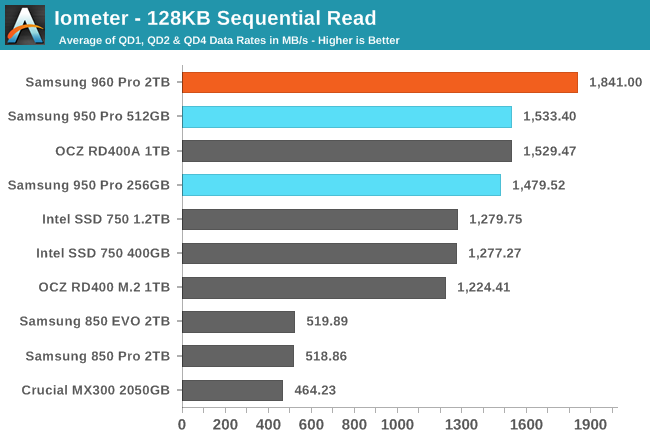
The 2TB 960 Pro's low queue depth sequential read speed is about 300MB/s faster than the 950 Pro, once again giving Samsung the clear lead in performance and showing that the 960 Pro is significantly better than the 950 Pro where thermal limits are a factor.
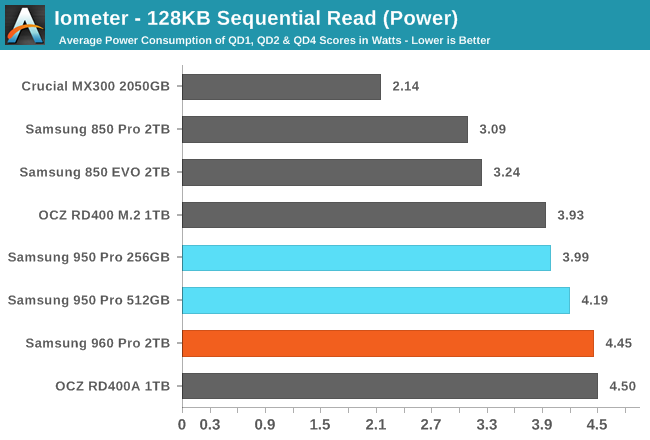
The 960 Pro consumes more power than its predecessors, but given the high performance it is the most efficient drive for this workload.
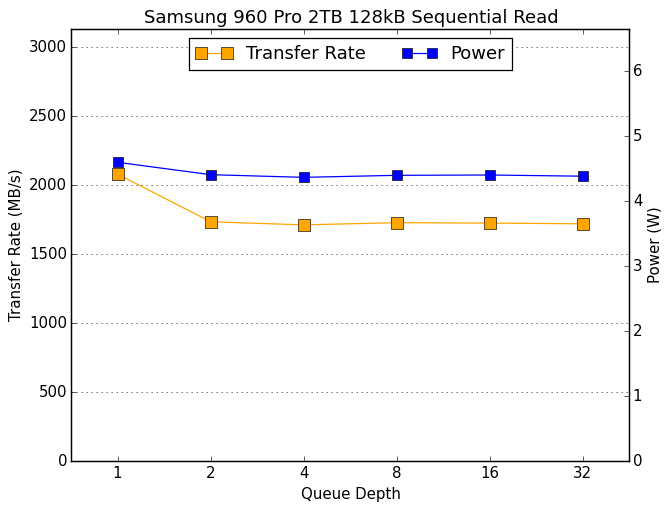 |
|||||||||
The slight drop in performance beyond QD1 indicates that the 960 Pro is still thermally limited for most of this test, and that like the 950 Pro it may perform much better with a heatsink.
Sequential Write Performance
The sequential write test writes 128kB blocks and tests queue depths ranging from 1 to 32. The queue depth is doubled every three minutes, for a total test duration of 18 minutes. The test spans the entire drive, and the drive is filled before the test begins. The primary score we report is an average of performances at queue depths 1, 2 and 4, as client usage typically consists mostly of low queue depth operations.
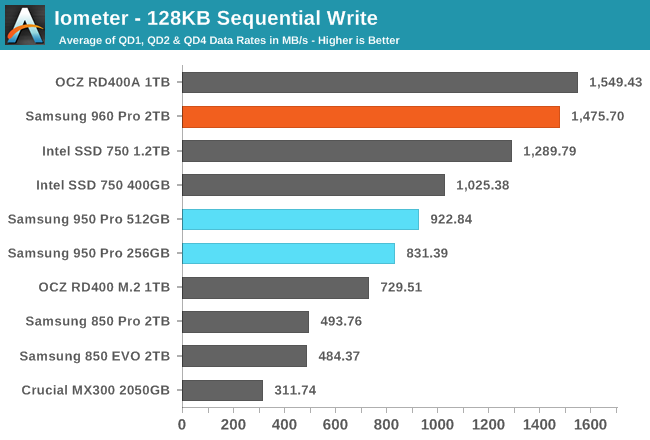
Thermals are an even bigger factor for the sequential write test than for sequential reads. The 960 Pro is 60% faster than the next fastest M.2 SSD and almost catches up to the RD400A with its thermal pad behind the controller allowing it to use its adapter card as a heatsink.
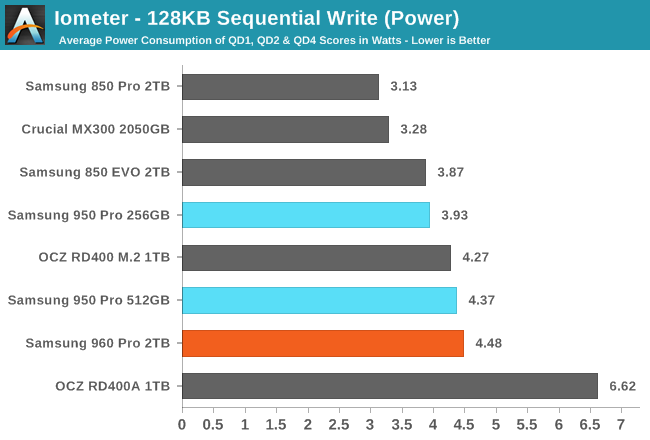
The 960 Pro's power consumption is only slightly higher than its M.2 competitors and far less than the RD400A. Given the performance, this makes the 960 Pro by far the most efficient SSD on this test, with about 30% higher performance per watt than the next most efficient drive.
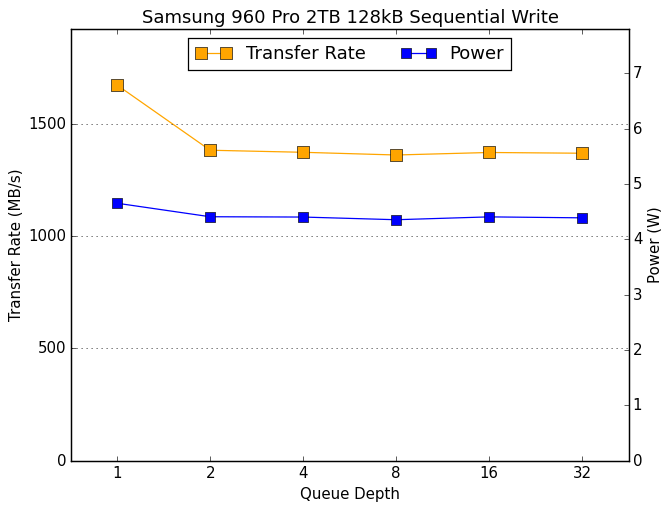 |
|||||||||
The QD1 performance of the 960 Pro is substantially higher than during the rest of the test where the drive is continuously thermally limited. The power consumption is only slightly higher at QD1 as the drive is able to spend a bit more power before its temperature gets up to the limit, then the drive reaches equilibrium at around 4.4W.










72 Comments
View All Comments
TheinsanegamerN - Tuesday, October 18, 2016 - link
Cant wait to see that, as it seems the 960 pro is thermally limited more often then not, especially on write tests. Hope to see even bigger improvements.eldakka - Wednesday, October 19, 2016 - link
But but but, since the controller is Polaris, doesn't the SSD handle your graphics too?I'll see myself out now.
BurntMyBacon - Wednesday, October 19, 2016 - link
@eldakkaNo. That would be Fiji. Though, I can see how it would be confusing. Even Ryan thought it was a Polaris 10 chip initially.
http://www.anandtech.com/show/10518/amd-announces-...
Waiting for a Polaris update to the Radeon Pro SSG. Throw some 960s (Polaris controllers) in to replace the 950s and things will get really confusing. ;')
VeauX - Tuesday, October 18, 2016 - link
Would migrating from an old Sandforce base SSD to this provide the same WOW effect than from mechanical to SSDs back in the days?GTRagnarok - Tuesday, October 18, 2016 - link
No, unless what you're doing involves reading or writing many gigabytes of data at a time in which case it'll be noticeably faster. Otherwise, the experience will be very similar compared to old SATA SSDs.AnnonymousCoward - Wednesday, October 19, 2016 - link
I have an absolutely brilliant idea. AT could just test that, and you wouldn't have to wonder and ask in the comments section!Mr Perfect - Tuesday, October 18, 2016 - link
This is kind of a chicken-and-the-egg problem, but has Samsung said anything about releasing these as U.2? Quite a few new motherboards have U.2 ports now, and putting these drives in the larger 2.5 inch form factor would make it possible to solve the overheating issues with heatsinks.Gigaplex - Tuesday, October 18, 2016 - link
It wouldn't be hard for a 3rd party to create a 2.5" adaptor that incorporates a heatsink.Mr Perfect - Wednesday, October 19, 2016 - link
You wouldn't think so, but I had a hell of a time finding one. All said and done, only one manufacturer seems to make an adapter to turn a M.2 into a U.2. Some company called microsatacables.com http://www.microsatacables.com/u2-sff8639-to-m2-pc...Some more native U.2 drives would be nice.
sircod - Tuesday, October 18, 2016 - link
Are you guys doing a review of the 600p? Not quite the same class as the 960 Pro, but I definitely want to see the 960 Evo compared to the 600p.